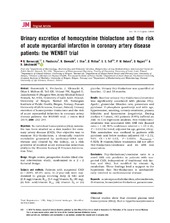Urinary excretion of homocysteine thiolactone and the risk of acute myocardial infarction in coronary artery disease patients: the WENBIT trial
Borowczyk, Kamila; Piechocka, Justyna; Głowacki, Rafał; Dhar, Indu; Midttun, Øivind; Tell, Grethe S.; Ueland, Per Magne; Nygård, Ottar; Jakubowski, Hieronim
Peer reviewed, Journal article
Published version

Åpne
Permanent lenke
https://hdl.handle.net/1956/19685Utgivelsesdato
2018Metadata
Vis full innførselSamlinger
Originalversjon
https://doi.org/10.1111/joim.12834Sammendrag
Objectives: No individual homocysteine (Hcy) metabolite has been studied as a risk marker for coronary artery disease (CAD). Our objective was to examine Hcy‐thiolactone, a chemically reactive metabolite generated by methionyl‐tRNA synthetase and cleared by the kidney, as a risk predictor of incident acute myocardial infarction (AMI) in the Western Norway B‐Vitamin Intervention Trial. Design: Single centre, prospective double‐blind clinical intervention study, randomized in a 2 × 2 factorial design. Subjects and methods: Patients with suspected CAD (n = 2049, 69.8% men; 61.2‐year‐old) were randomized to groups receiving daily (i) folic acid (0.8 mg)/vitamin B12 (0.4 mg)/vitamin B6 (40 mg); (ii) folic acid/vitamin B12; (iii) vitamin B6 or (iv) placebo. Urinary Hcy‐thiolactone was quantified at baseline, 12 and 38 months. Results: Baseline urinary Hcy‐thiolactone/creatinine was significantly associated with plasma tHcy, ApoA1, glomerular filtration rate, potassium and pyridoxal 5′‐phosphate (positively) and with age, hypertension, smoking, urinary creatinine, plasma bilirubin and kynurenine (negatively). During median 4.7‐years, 183 patients (8.9%) suffered an AMI. In Cox regression analysis, Hcy‐thiolactone/creatinine was associated with AMI risk (hazard ratio = 1.58, 95% confidence interval = 1.10–2.26, P = 0.012 for trend; adjusted for age, gender, tHcy). This association was confined to patients with pyridoxic acid below median (adjusted HR = 2.72, 95% CI = 1.47–5.03, P = 0.0001; Pinteraction = 0.020). B‐vitamin/folate treatments did not affect Hcy‐thiolactone/creatinine and its AMI risk association. Conclusions: Hcy‐thiolactone/creatinine ratio is a novel AMI risk predictor in patients with suspected CAD, independent of traditional risk factors and tHcy, but modified by vitamin B6 catabolism. These findings lend a support to the hypothesis that Hcy‐thiolactone is mechanistically involved in cardiovascular disease.
